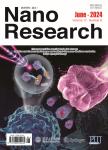Engineering magnetic nanostructures with inverse hysteresis loops
Engineering magnetic nanostructures with inverse hysteresis loops作者机构:Dpto. de Quimica-Fisica Universidad del Pais Vasco UPWEHU 48940 Leioa Spain IFIMUP-IN and Dept. Fisica e Astronomia Universidade do Porto 4169007 Porto Portugal Dpto. de Qulmica-Ffsica & BCMaterials Universidad del Pals Vasco UPV/EHU 48940 Leioa Spain IKERBASQUE Basque Foundation for Science 48011 Bilbao Spain
出 版 物:《Nano Research》 (纳米研究(英文版))
年 卷 期:2016年第9卷第8期
页 面:2347-2353页
核心收录:
学科分类:0808[工学-电气工程] 07[理学] 0809[工学-电子科学与技术(可授工学、理学学位)] 0805[工学-材料科学与工程(可授工学、理学学位)] 0702[理学-物理学]
基 金:supported by Basque Country Government grant Nanoikerll support provided by SGIker Laser and X-ray Facilities(UPV/EHU, MICINN, GV/EJ, ESF)
主 题:magnetic nanostructures,magnetic patterning effects,inverted loops,negative coercivity,negative remanence
摘 要:Top-down lithography techniques allow the fabrication of nanostructured elements with novel spin configurations, which provide a new route to engineer and manipulate the magnetic response of sensors and electronic devices and understand the role of fundamental interactions in materials science. In this study, shallow nanostructure-patterned thin films were designed to present inverse magnetization curves, i.e., an anomalous magnetic mechanism characterized by a negative coercivity and negative remanence. This procedure involved a method for manipulating the spin configuration that yielded a negative coercivity after the patterning of a single material layer. Patterned NiFe thin films with trench depths between 15%-25% of the total film thickness exhibited inverse hysteresis loops for a wide angular range of the applied field and the trench axis. A model based on two exchange-coupled subsystems accounts for the experimental results and thus predicts the conditions for the appearance of this magnetic behavior. The findings of the study not only advance our understanding of patterning effects and confined magnetic systems but also enable the local design and control of the magnetic response of thin materials with potential use in sensor engineering.



